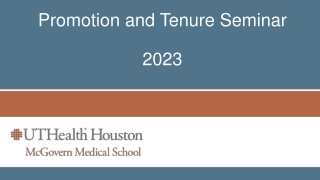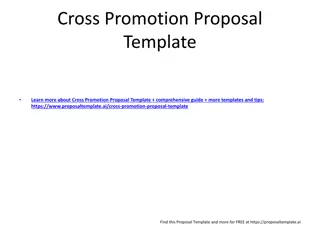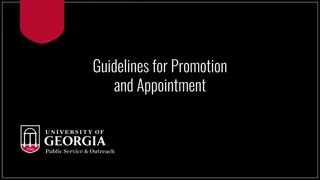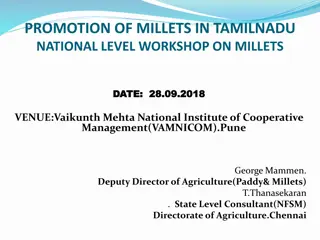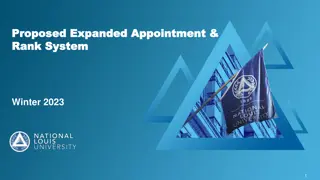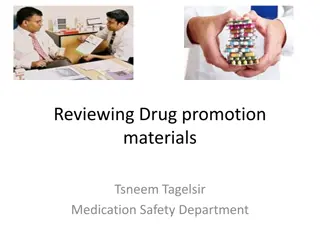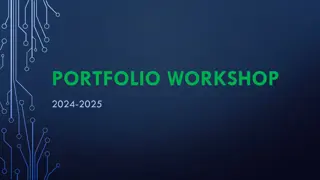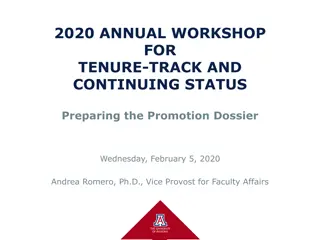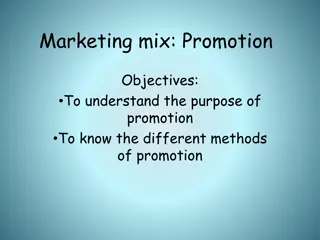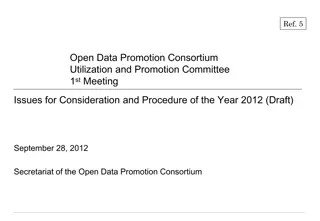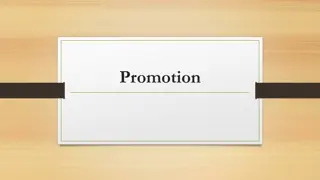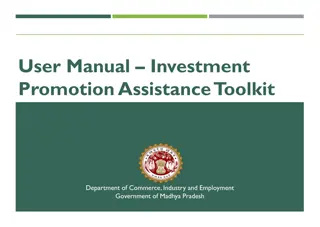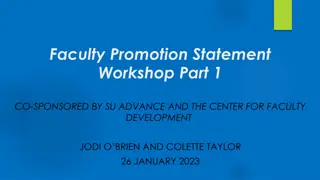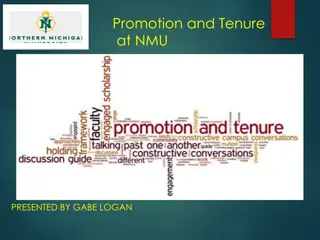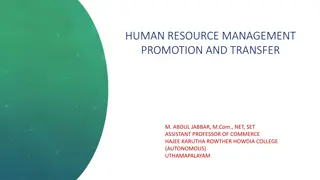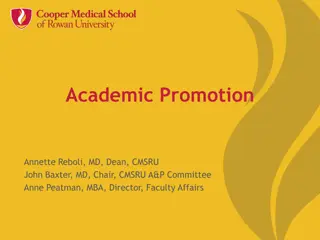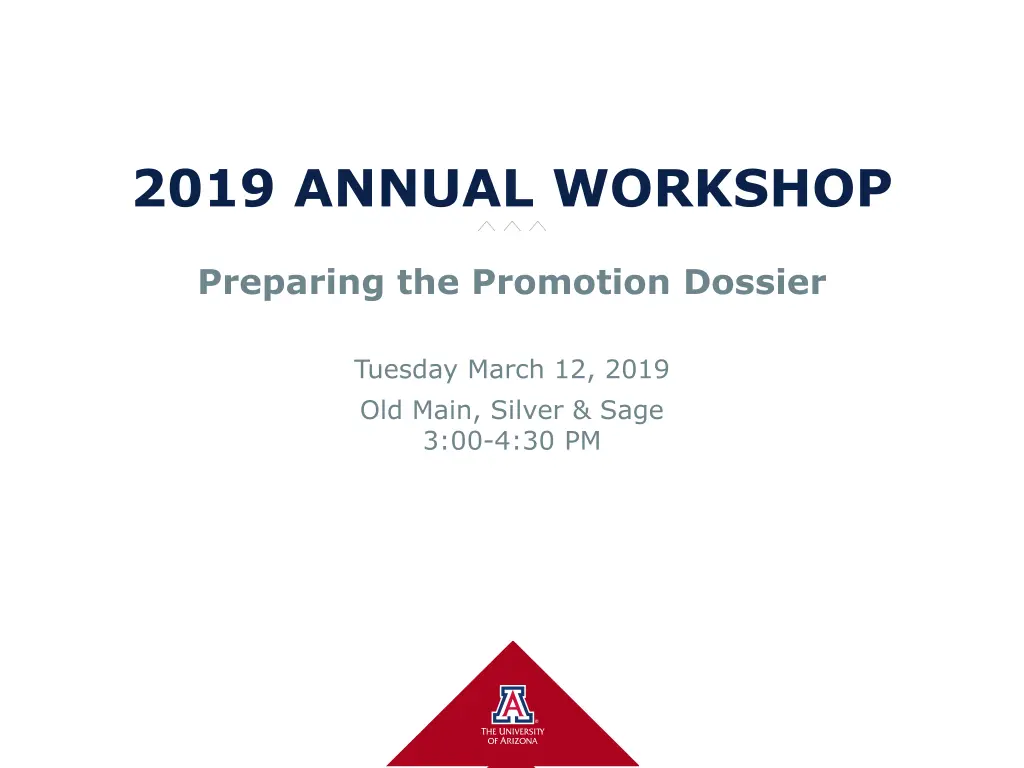
Promotion Dossier Workshop Agenda & Process Overview
Explore in-depth insights on preparing for promotion reviews, the promotion dossier, evaluation of teaching, and valuable resources provided at the Annual Workshop. Gain knowledge on the promotion review process, essential steps for candidates, and requesting delays in reviews for various reasons.
Download Presentation

Please find below an Image/Link to download the presentation.
The content on the website is provided AS IS for your information and personal use only. It may not be sold, licensed, or shared on other websites without obtaining consent from the author. If you encounter any issues during the download, it is possible that the publisher has removed the file from their server.
You are allowed to download the files provided on this website for personal or commercial use, subject to the condition that they are used lawfully. All files are the property of their respective owners.
The content on the website is provided AS IS for your information and personal use only. It may not be sold, licensed, or shared on other websites without obtaining consent from the author.
E N D
Presentation Transcript
2019 ANNUAL WORKSHOP Preparing the Promotion Dossier Tuesday March 12, 2019 Old Main, Silver & Sage 3:00-4:30 PM
Agenda Introductions Preparing for Promotion Reviews The Promotion Review Process The Promotion Dossier Evaluation of Teaching & Provost Award for Innovations in Teaching Teacher Course Evaluation Reports (TCEs) Continuing Status Reviews Promotion Resources Handout
Introductions Andrea Romero Vice Provost for Faculty Affairs David Nix Co-Chair, University P&T Committee Denise Roe Member, University P&T Committee Ingrid Novodvorsky Director, Teaching, Learning & Assessment Office of Instruction and Assessment Gabriel Rodriguez Coordinator, Operations Office of Instruction and Assessment
The Promotion Process Starts Where the Hiring Process Ends Department Heads Should Specify criteria and expectations for promotion. Provide clarity about workload distribution. Be precise on areas needing improvement. Use annual reviews to help candidates set goals. Help candidates articulate their goals and needs. Provide a thorough 3rd year review comments and guidance. Help candidate identify mentors. Help candidates prioritize service commitments. Help candidate identify awards/opportunities for recognition of work. Help limit new teaching preparations and align teaching and research interests. Keep good records. Identify national/international experts in candidate s field of work.
The Promotion Process Starts Where the Hiring Process Ends Candidates Should Identify and stay in regular touch with mentors Keep an eye out for external reviewers. Review and discuss promotion criteria. Understand workload distribution Share your writing with colleagues. Use annual reviews to Discuss your program of work, Set limits and priorities, and Solicit frank assessments. Talk to senior faculty about how they assess impact, national standing, and quality. Solicit peer review and classroom observations
Requesting Delays in Reviews Submit requests at least one semester before the review. Birth or Adoption Prestigious External Commitments that take time away from research Personal Reasons such as personal health or family or partner health and care Adverse Professional Circumstances that are beyond the candidate s control
The Promotion Review Process Levels of Reviews External Reviewer Letters Department Review College Review University Review University Committee College Committee Department Committee Provost Dean Department Head or Director
Protect the Process to Ensure Fair Reviews External and internal reviewers cannot be collaborators. Use Collaborator Letters from those who are not independent. Sign and date committee letters. Explainvotes, recusals and abstentions. Notify Candidates about teaching reviews and when forwarding dossiers. Follow the Guide to the Promotion Process. Consult with your dean or the Provost s Office on procedural variations or questions. Base decisions on department and college criteria. Follow formats in Dossier Template
Selecting External Reviewers Solicited by the Department Head or the Committee Chair. Use the required template for requesting letters. External Reviewers MUST be independent and at or above the rank the candidateis being reviewed for promotion. Include all solicited letters. Place external reviews before collaborator letters. Only head or committee chair contacts outside reviewers. Submit brief bios of external reviewers, not CVs. No more than half can come from candidate s list. Prioritize external letters from experts at peer institutions. Document the selection process.
Selecting External Reviewers List of Peer Institutions University of California, Davis University of North Carolina, Chapel Hill University of California, Los Angeles University of Minnesota, Twin Cities University of Florida Ohio State University University of Illinois, Urbana- Champaign Pennsylvania State University University of Iowa University of Texas, Austin University of Maryland, College Park Texas A&M University University of Washington Michigan State University University of Wisconsin, Madison
The Promotion Dossier Section # Title Prepared By Section 1: Summary Data Sheet Dept. Administration Dept. Admin, Head/Director & Candidate Section 2: Summary of Candidate's Workload of Assignment Section 3: Dept. & College Criteria (not the full guide) Dept. Administration Section 4: Curriculum Vitae & List of Collaborators Candidate Section 5: Candidate Statement Candidate Section 6: Teaching Portfolio Candidate Evaluation of Teaching & Recommendation for Provost Award Section 7: Dept. Committee Section 8: Portfolio to Document Leadership in Service & Outreach Candidate Candidate, GIDP Chair & Dept. Committee Section 9: Membership in Graduate Interdisciplinary Programs Dept. Administration, Committee Chair & Head/Director Section 10: Letter from Outside Evaluators & Collaborators Section 11: Recommendations (from Internal Reviewers) Dept., College & Univ. Levels Refer to the Guide for tips on preparing dossiers
Section 2: Workload Assignment Prepared by the Department Head The Workload Assignment should be kept current and accurate. Use percentages and define meaning 40% teaching, which means ... number of courses 40% research, which means ... 20% service, which means ... Describe duties, do not praise achievements. Use the template provided in the dossier. Electronic signatures are acceptable.
Sections 4 & 5: Documenting and Discussing Your Achievements Follow the required CV format exactly. Get models for CVs and Candidate Statements. Keep records of service and teaching contributions. Use the Candidate Statement to Characterize your research and teaching goals, methods, and results; Connect with teaching and service dossiers; and Thereby demonstrate the impact of your work.
Using Your Candidate Statement to Represent Your Teaching What do you teach, and who are your students? How do you use active learning strategies? How do you assess their progress? Goals: Learning Outcomes Student Engagement Interpersonal dynamics Methods: Curricular design Modes of instruction Context Management Assessment and Impact: In-class student feedback Peer assessments TCE reports Letters from students Broader contributions
Section 6: The Teaching Portfolio The Candidate Statement sets up the Portfolio. Instructional materials (such as syllabi, slide presentations, class assignments and curricular reports) stay at the department-level of the review. List all courses taught in period in rank. List the funded and pending awards and grants. Document advising and mentoring. Describe development activities.
Evaluation of Teaching & TCE Reports Office of Instruction and Assessment
Section 7: Evaluating Teaching & TCE Reports Recommendation for Provost Award A memo with a peer review of the teaching is required, in addition to the general department letter. This memo includes: a summary of teaching observation(s), a review of student evaluations and TCE scores with a discussion of comparison to faculty, and an assessment of the Teaching Portfolio (section 6) Use Peer Review of Teaching Protocol to conduct at least one (within 1 year) teaching observation. Summarize TCE reports and obtain independent student commentsfrom your department s TCE representative. NEWCommittee s summary of TCE scores is included in this section and not the TCE reports.
TCE Consultation & Support Services Assistance to committees and faculty accessing & interpreting TCEs. Consultation with heads or committees on Using ratings in annual and performance reviews and Identifying additional TCE questions to assess curricula and student support. Contact: Rebecca P rez Assistant Director, Instructional Data Office of Instruction and Assessment rperez@email.arizona.edu and 520-626-0536
What Do TCEs Measure? Student experiences, perceptions, feelings, self- reflections on their effort and learning, self assessment on performance and expected grade, self efficacy, etc. TCEs can measure students perceptions of instructor and course effectiveness in support of their program completion and perceived learning. What Do TCEs NOT Measure? Student learning and grades. Research has found that the gender, ethnicity and sexual orientation of faculty can have a significant impact on student evaluations.
Section 7: Evaluating Teaching & TCE Reports Recommendation for Provost Award Committees are encouraged to use their peer review memos to recommend candidates for the Provost Award for Innovations in Teaching. Award criteria: active learning strategies and other evidence-based instructional practices; well-structured course syllabi with well-defined learning outcomes; inclusive teaching strategies and course content to address diverse learning styles and experiences; involvement in workshops and collaborative reforms of teaching; strong TCE and student comments; teaching awards, grants, and other recognized achievements in teaching; and effective mentoring and advising, including collaborations with students from diverse backgrounds
8: Service and Outreach Portfolio This section is an option for P&T candidates, but all candidates should discuss the impact of their service. This section may be required for continuing status reviews that include educational outreach. In P&T reviews, these materials remain in departments. What to Include? Technical reports, research studies, and presentations Articles for popular publications and instructional materials, What to include in the dossier to document impact? Letters from community collaborators noting impact Letters from research collaborators noting rigor and innovation News reports on service contributions Adoptions of programs and materials by other institutions
Administrator Notifications to Candidates Candidates are notified by the department head or director and dean when their dossier has moved forward to the next level of the review. This is required for candidates under review. The written notifications to the candidate can be included in the dossier. Review the policy in the University Handbook for Appointed Personnel (UHAP) 3.3.02C, for more information.
Additions to Dossiers? Up to February 1, additions may be made (for example, a major grant or publication). However, the addition must be requested by an administrator or committee chair. Additions require re-review at earlier levels. Candidate must be informed. Candidate must be given chance to respond if the information is negative (such as poor teaching evaluations).
Appeals of Promotion Decisions The Provost s decision may be appealed, as detailed in UHAP 3.3.02.e and UHAP 4A.3.02. Appeals to the President must be made in writing within 30 days of the Provost s decision. Access to redacted dossier is provided following the Provost s Office protocol. The President s decision is final, except in cases of discrimination or unconstitutional violations of due process.
Distinctive Aspects of Continuing-Status Reviews CS reviews consider position effectiveness as well as teaching, research & service. Thus, the job description and allocation of time are even more important. Work with your supervisor to align your duties with your unit s guidelines for promotion, and Make sure to document your contributions to publications and grants. Finally, develop an assessment plan to demonstrate the impact of your activities.
Your Job Description Sets Your Baseline Explain your contributions in non-technical terms. Include all job descriptions and note changes. Often job descriptions include statements of duties that are used to assess position effectiveness. Duties should be divided into four categories: Research/Scholarship/Creative Activity, Outreach/Service, Teaching/Educational Outreach, and Position Effectiveness
Specify your Duties Accurately Workload areas CALS CALS Curator Librarian Research/scholarly /creative activity 30% 10% 40% 20% Extension 50% 70% Teaching Service/Outreach 20% 20% 60% 10% Position Effectiveness 70% If you select Other Professional Activities, list and specify the duties.
Use Your Dossier to Document Your Impact Address non-specialists as well as experts. Make sure your head or committee chair understands who would be appropriate reviewers. Use the Candidate Statement and to discuss the progress and impact of your program of work. Discuss soliciting collaborator letters to document the impacts of your work. Document your efforts to improve your teaching. Consider asking graduates and former students for letters. Use the Service and Outreach Portfolio to document your leadership contributions.
Using Teaching and Outreach Portfolios to Document Impact Thursday, March 21 8:30-10 am Old Main, Silver & Sage This workshop focuses on how to use the Teaching and Service Portfolios to document your leadership and impact, the process for conducting peer reviews of teaching, and the Teacher-Course Evaluation (TCE) reports that are used in P&T. Service portfolios can be especially useful if you Developed outreach and teaching initiatives, Have leadership or administrative duties to document, or Are on the continuing-status track.
Promotion Opportunities for Faculty not on the Tenure Track Wednesday, March 27, 2:00-3:30 Old Main, Silver and Sage This workshop provides a hands-on opportunity to learn about resources and strategies for engaging in conversations with supervisors about promotion. We will take note of recent revisions and go over the kinds of materials you may want to prepare for a promotion review.
Questions? Contact us. We are part of your support team: Andrea J. Romero, Vice Provost for Faculty Affairs romeroa@arizona.edu Asya Roberts, Executive Associate asya@arizona.edu, (520) 626-0202 Webpage: facultyaffairs.arizona.edu

